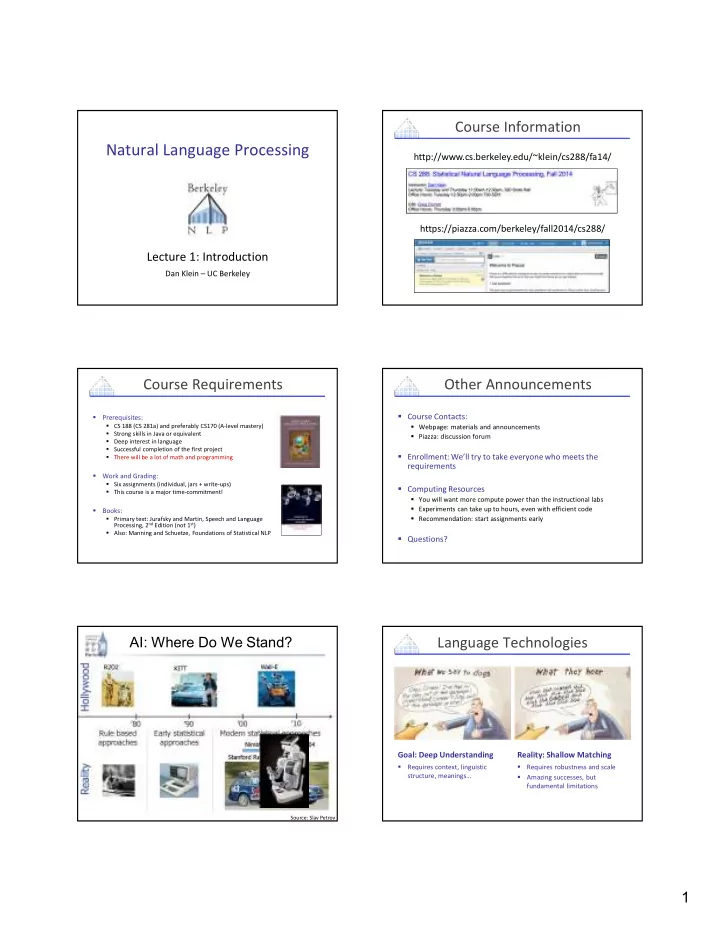

Course Information Natural Language Processing http://www.cs.berkeley.edu/~klein/cs288/fa14/ https://piazza.com/berkeley/fall2014/cs288/ Lecture 1: Introduction Dan Klein – UC Berkeley Course Requirements Other Announcements � Course Contacts: � Prerequisites: � CS 188 (CS 281a) and preferably CS170 (A-level mastery) � Webpage: materials and announcements � Strong skills in Java or equivalent � Piazza: discussion forum � Deep interest in language � Successful completion of the first project � Enrollment: We’ll try to take everyone who meets the � There will be a lot of math and programming requirements � Work and Grading: � Six assignments (individual, jars + write-ups) � Computing Resources � This course is a major time-commitment! � You will want more compute power than the instructional labs � Experiments can take up to hours, even with efficient code � Books: � Primary text: Jurafsky and Martin, Speech and Language � Recommendation: start assignments early Processing, 2 nd Edition (not 1 st ) � Also: Manning and Schuetze, Foundations of Statistical NLP � Questions? ���������������������� Language Technologies Goal: Deep Understanding Reality: Shallow Matching � � Requires context, linguistic Requires robustness and scale structure, meanings… � Amazing successes, but fundamental limitations Source: Slav Petrov �
Speech Systems Example: Siri � Siri contains � Automatic Speech Recognition (ASR) � Speech recognition � Audio in, text out � SOTA: 0.3% error for digit strings, 5% dictation, 50%+ TV � Language analysis � Dialog processing � Text to speech ������������ � Text to Speech (TTS) � Text in, audio out � SOTA: totally intelligible (if sometimes unnatural) Image: Wikipedia Text Data is Superficial … But Language is Complex �� ������� �� � ����� ����� �� �� ������� �� � ����� ����� �� ���������� ��� ���� ��� ���������� ��� ���� ��� ������ ��� ��� � ����!��� �� ������� �� ��� ������ ��� ��� � ����!��� �� ������� �� ��� ����� ��� ����� ��� �� �������� �� ���� �����" �� �������� �� ���� �����" � Semantic structures � References and entities � Discourse-level connectives � Meanings and implicatures � Contextual factors � Perceptual grounding � … Deeper Linguistic Analysis Learning Hidden Syntax ����������������������� ����� �� ���� ��� ����� �� �� ���� ����� �� �� � ��� �������������� ������ ���� ���� �� �� ������ !��� ��"��� !���� ����� !� #� $� ������������������������������������������������������������������ ����� %��� �����&� ������ ��������������������������������������������������������������������� � �����' ��( ��� )��� ������!��������������������"���#�����������������������$ ����� *��+ ,�������� ������ ���#���$��%&' �
Search, Facts, and Questions Example: Watson Summarization Language Comprehension? � Condensing documents � Single or multiple docs � Extractive or synthetic � Aggregative or representative � Very context- dependent! � An example of analysis with generation Machine Translation � Translate text from one language to another � Recombines fragments of example translations � Challenges: � What fragments? [learning to translate] � How to make efficient? [fast translation search] � Fluency (next class) vs fidelity (later) (
Data By Itself Isn’t Enough! More Data: Machine Translation *�����������#������#������#�����������������+#����� ����������� �123*4 ����#����,���� ��,�#����������,�-���#���������������" .������#��������������� ����#�������������#��� ������������������� 526�7 ���������������������������������������������� �" /����0�/�������#�����0�/����������0�/�����������0�/���0�/��� �������0� �8���.� /��������0�/��0�/��� �0�/��0�/�0�/�������0�/��0�/-��#�0�/�������������0�/"0 /��0��/��#��0�/�����#����0�/������������0�/�����0�/��#��0�/��0�/����0� �&8���.� /��0�/��� 0�/����0�/�������0�/��0�/-��#�0�/�������0�/"0 /����0�/��#�����0�/������������������#����0�/��������#��0�/�������0�/�� �&&8���.� �������0�/������$��������0�/"0 /�������#�����0�/������������������#����0�/��������#��0�/�-���#���$� �&&&8���.� �������0�/�����������������0�/"0 Data and Knowledge � Classic knowledge representation worry: How will a machine ever know that… � Ice is frozen water? � Beige looks like this: � Chairs are solid? � Answers: � 1980: write it all down � 2000: get by without it � 2020: learn it from data Names vs. Entities Deeper Understanding: Reference )
Example Errors Discovering Knowledge Grounded Language Grounding with Natural Data ������������������������ What is Nearby NLP? Example: NLP Meets CL � Computational Linguistics � Using computational methods to learn more about how language works � We end up doing this and using it � Cognitive Science � Figuring out how the human brain works � Includes the bits that do language � Humans: the only working NLP prototype! � Speech Processing � Mapping audio signals to text � Traditionally separate from NLP, converging? � Two components: acoustic models and language � Example: Language change, reconstructing ancient forms, phylogenies models � Language models in the domain of stat NLP … just one example of the kinds of linguistic models we can build 9
Recommend
More recommend